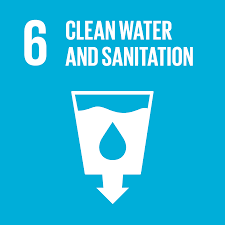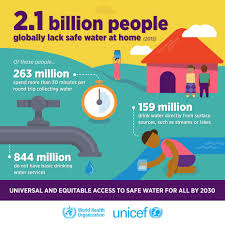Access to drinking water in European countries, comparison to rest of world
Safe and readily available water is important for public health, whether it is used for drinking, domestic use, food production or recreational purposes. Improved water supply and sanitation, and better management of water resources, can boost countries’ economic growth and can contribute greatly to poverty reduction.
In 2010, the UN General Assembly explicitly recognized the human right to water and sanitation. Everyone has the right to sufficient, continuous, safe, acceptable, physically accessible, and affordable water for personal and domestic use.
 Sustainable Development Goal target 6.1 calls for universal and equitable access to safe and affordable drinking water.The target is tracked with the indicator of “safely managed drinking water services” – drinking water from an improved water source that is located on premises, available when needed, and free from faecal and priority chemical contamination.
Sustainable Development Goal target 6.1 calls for universal and equitable access to safe and affordable drinking water.The target is tracked with the indicator of “safely managed drinking water services” – drinking water from an improved water source that is located on premises, available when needed, and free from faecal and priority chemical contamination.
In 2017, 5.3 billion people used safely managed drinking-water services – that is, they used improved water sources located on premises, available when needed, and free from contamination. The remaining 2.2 billion people without safely managed services in 2017 included:
-
1.4 billion people with basic services, meaning an improved water source located within a round trip of 30 minutes
-
206 million people with limited services, or an improved water source requiring more than 30 minutes to collect water
-
435 million people taking water from unprotected wells and springs
-
144 million people collecting untreated surface water from lakes, ponds, rivers and streams
-
Source: World Health Organisation
Progress of SDG 6 in 2019:
 Despite progress, billions of people still lack safe water, sanitation and handwashing facilities. Data suggests that achieving universal access to even basic sanitation service by 2030 would require doubling the current annual rate of progress. More efficient use and management of water are critical to addressing the growing demand for water, threats to water security and the increasing frequency and severity of droughts and floods resulting from climate change. As of the time of writing, most countries are unlikely to reach full implementation of integrated water resources management by 2030.
Despite progress, billions of people still lack safe water, sanitation and handwashing facilities. Data suggests that achieving universal access to even basic sanitation service by 2030 would require doubling the current annual rate of progress. More efficient use and management of water are critical to addressing the growing demand for water, threats to water security and the increasing frequency and severity of droughts and floods resulting from climate change. As of the time of writing, most countries are unlikely to reach full implementation of integrated water resources management by 2030.
- Globally, the proportion of population using safely managed drinking water services increased from 61 to 71 per cent between 2000 and 2015 and remained unchanged in 2017. An additional 19 per cent of the global population used basic drinking water services. This means that 785 million people still lacked even a basic drinking water service.
- The global population using safely managed sanitation services increased from 28 per cent in 2000 to 43 per cent in 2015 and to 45 per cent in 2017, with the greatest increases occurring in Latin America and the Caribbean, sub-Saharan Africa and East and South-East Asia.
- In 2017, some 60 per cent of people worldwide and only 38 per cent in least developed countries had a basic handwashing facility with soap and water at home, leaving an estimated 3 billion people without basic handwashing facilities at home.
- In 2016, one third of all primary schools lacked basic drinking water, sanitation and hygiene services, affecting the education of millions of schoolchildren, but particularly girls managing menstruation, and one in four health-care facilities worldwide lacked basic water services, affecting more than 2 billion people.
More Information: Report of the UN Secretary-General: progress towards the Sustainable Development Goals.
Drinking Water Access in Europe:
Most people living in the EU enjoy good access to high quality drinking water. Tap water is free in European schools. Drinking water in Europe is abstracted from different sources, main sources are groundwater and surface water. EU water policy focuses on protecting water resources. The EU Water Framework Directive (WFD) is designed to achieve good ecological status and enable sustainable use of water. The new Drinking Water Directive states that drinking water should become better throughout Europe, specially with stricter pollutant limits, and be available to all citizens.
More information about the drinking water access you will find in Chapter 3.

.png)

